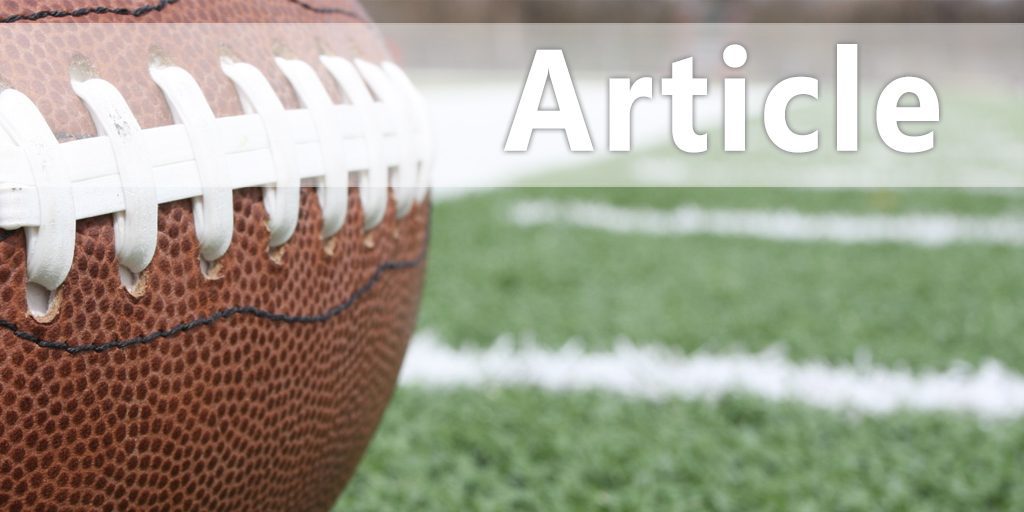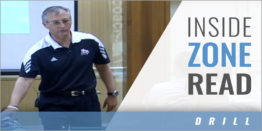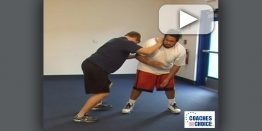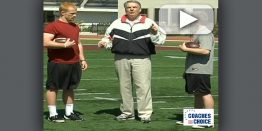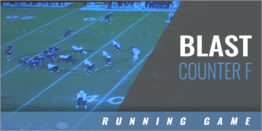| Heavy 3-5-3 Defense with a Shade Front
Thank you. I want to get right into the defensive lecture as I have a lot of information I want to share. Often, we are asked what makes our defense different from other 3-5 schemes. First, I will give you a brief history and the purpose why we moved to this defensive scheme. In 2001 at the state championship game, we began a variation of this defense due to the fact our opponents deployed an offense that spread us out across the field. We were playing a 4-2 look, so we took our strongside end and walked him off the line, and backed him off. That was the start of changing our defense. During the off-season, Coach Rod White began studying the 3-5 defensive systems. He found there were several things about the 3-5 that other teams were doing that we didn't like, such as blitzing, playing head-up, and slanting their linemen. A lot of our kids play both ways, and we didn't think it was possible for them to play that style of defense the whole game. We chose to take the old shade 52 and combine it with the 3-5 look. Over the past several years, we have integrated other defensive principles to create a custom fit for our style of play and our athletes. Our base is the 3-5 alignment (Diagram #1). We like this defense because it gives us so much versatility against the various offenses we face today. The tackle on the tight end plays a 7 technique. The nose is shaded to the tight end. The backside tackle aligns in a 4 technique. This is our base defense, which we call "Wolf heavy." 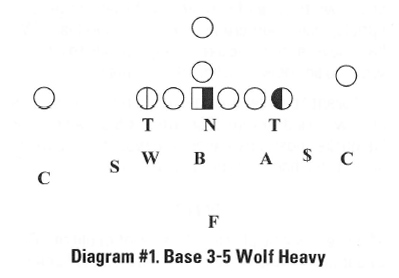 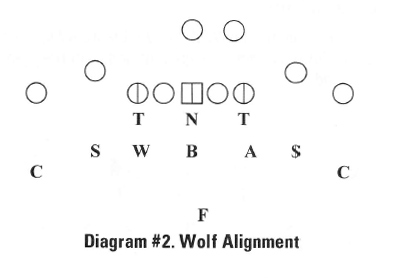 This defense allows us to call our strength to the wideside. We have the tight end to our weakside. The nose uses his heavy technique to the tight end side, and the two tackles trade responsibilities (Diagram #3). The ace and weak backer trade spots. We do this so the offense can't dictate who they want to run at or throw at. DEFENSIVE LINE PLAY 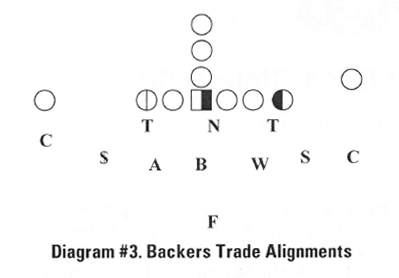 This alignment is Wolf heavy (Diagram #4). This is the down lineman's alignment and who they jam and read. 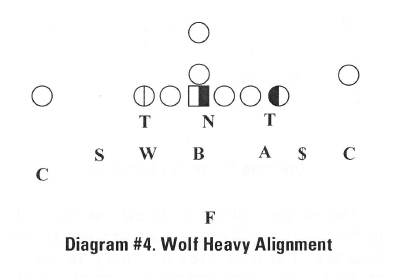 • Strong tackle: Lines up on the inside eye of the tight end; jams the tight end, and reads the tackle. • Nose: Lines up on the strongside eye of the center, jams the center and the guard. • Weak tackle: Lines up head-up on the tackle and reads the tackle. This is what we look for at each of those three down line positions. There are certain characteristics that we are looking for in each position. • Strong tackle: Is our biggest down lineman; we want him to be big and athletic. Next, I want to talk about jam and read techniques. First is the jam. The most-important priority that our linemen are taught is to be able to jam and control the line of scrimmage. The jam is a fairly simple process of squeezing the line of scrimmage, reacting to movement quickly and explosively. We want them to get both hands into the offensive linemen on the breastplate on their shoulder pads. We do not want our defensive linemen to use their face mask to create separation. Our defensive linemen are smaller than most offensive linemen, and if they put their face in the shoulder pads they get blocked and they can't see. During the season, they will jam every Monday and Tuesday at practice. Next is the read. The read is much more difficult for players to grasp, and it takes a tremendous amount of time and repetition. To help us to read, we do a drill called the "three-way read drill." During pre-season, we do the drill every day. During the season, we do it on Monday and Tuesday. We also teach our down lineman to jam one player and read the block of another player. For example, our strong tackle will jam the tight end and read the tackle. We want to teach our linemen to take proper pursuit angles and how to move up and down the line of scrimmage. We do not want our defensive linemen to get upfield. They are coached to work up and down the line of scrimmage. If they are getting upfield, then they are not getting a good jam. We have several drills we use to help our kids to jam and work up and down the line of scrimmage. I want to cover our linebacker play and discuss how we are different than other 3-5 schemes. Our linebacker positions are as follows: strong safety, ace, strong backer, weak backer, and spy. BLITZ Following are our alignments for the five linebackers. We play all of these positions four to five yards deep. I want to give you a short comment about each position:
This is how we line up in the secondary. Linebackers are not included in this alignment.
I want to show you how we line up against a twins set with a tight end away from the slot (Diagram #5). We make the adjustment with our field corner and strong backer. 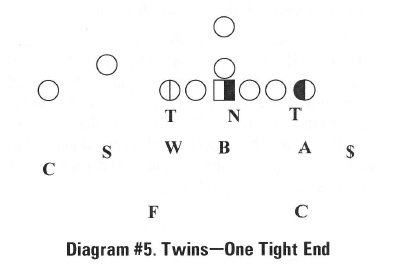 I want to cover five different adjustments we make with our Wolf heavy 3-5 defense. These are simple adjustments that can be made during the course of the game, depending upon the type of offensive sets we face. First is the Wolf heavy switch (Diagram #6). The first question we must ask is: why? Why do we want to switch? It is important that the tackle not get reached, and it is important that the ace does not get down blocked. 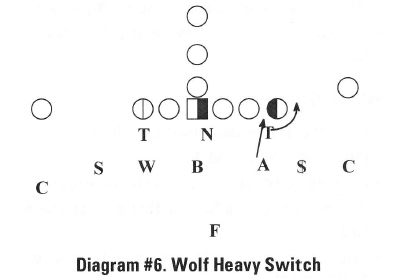 • Changes who has quarterback and who has dive. • Changes the cutoff player if the play is going away. • Changes blocking schemes. • Can give you a delayed blitz on a pass rush. • Will use on the strongside most of time; will use it on the weakside some (depends on what type of offense we are playing against). • Gives players ownership to call it "on" or "off." Next is our Wolf heavy space adjustment (Diagram #7). I plan to cover when we use it and what it offers us. This is great against the spread because it allows us to effectively play the slant from all slant receivers. We can unload the box after the speed teams have counted the box players. This works well against option teams and teams that use rules for blocking defenses. 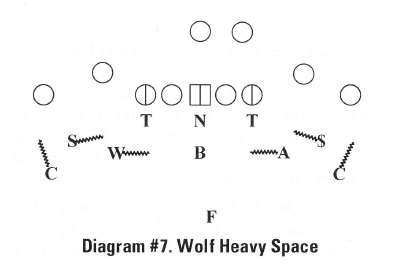 • We use this when teams are spreading us out. • We like to use this when ball is in the middle of field. What It Offers Our next adjustment is our Wolf heavy spy adjust (Diagram #8). I want to make one important point: this is not a called defense. The spy learns throughout the week when to adjust. This is determined by offensive formation, field position, and the down-and-distance.  Closer to the boundary = closer to formation, plus added depth. He never aligns outside of the #2 receiver, unless the #2 receiver is a tight end. When Why Next, we go to our Wolf heavy banjo adjustment (Diagram #9). When do we use this adjustment? We use it to cover wide receivers by sliding the defense. We dare the offense to run into the boundary on this adjustment. Following are our options on the adjustment. 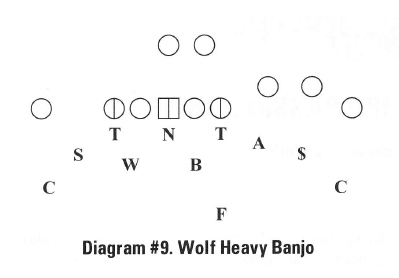 • Allows ace to adjust to formations. • Can bring ace off edge. • Can drop ace into coverage and bring strong backer for contain. • Can slide spy back. • Can play multiple coverages. Our last adjustment is our Wolf heavy bite (Diagram #10). It is our zone blitz. This is how it looks. 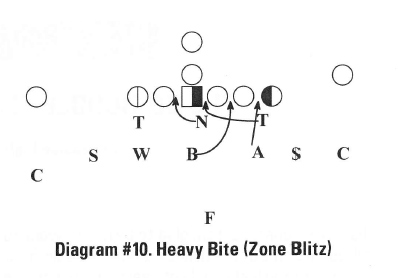 • Nose: Crosses the face of the center. • Weak tackle: Has to have contain out the backside. • Strong backer: Comes through the B gap. • Ace: Comes on outside for contain. I will be around if you have any questions. It has been a big year for us. We have won the state championships eight times. We were fortunate to win it again last year. If you are interested in anything we do, just contact me. Thank you. |
|
|
